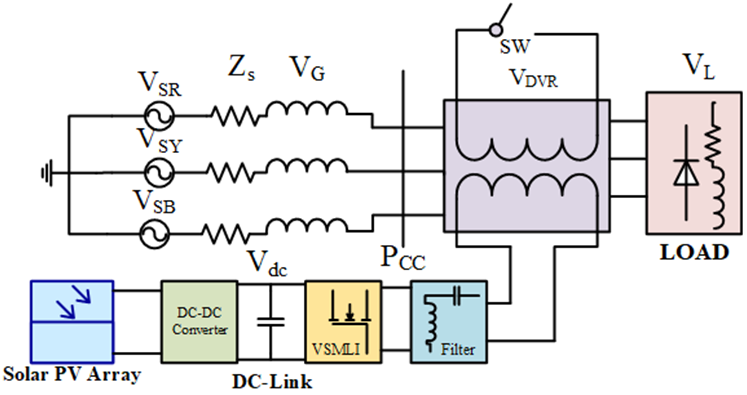Power quality enhancement of grid-integrated solar photovoltaic system with unified power quality conditioner
DOI:
https://doi.org/10.20998/2074-272X.2024.6.06Keywords:
grid integration, unified power quality conditioner, power quality, photovoltaic arrayAbstract
Introduction. To enhance the quality of power and ensure a consistent electricity supply, this study proposes the utilization of a unified power quality conditioner (UPQC) system integrated with solar photovoltaic (PV) technology. The innovation involves single DC-link connecting back-to-back voltage-compensating components arranged in series and shunt, forming the PV-UPQC. The shunt compensator utilizes energy from a PV array to address harmonics in the load current. The objective is to mitigate voltage dips and spikes by injecting voltage that is either in phase with or out of phase with the common coupling point through a series compensator. The method combines the benefits of generating renewable energy to enhance electrical quality. The goal of the paper is the power quality enhancement of grid-integrated solar PV system. The novelty of the proposed work consists of enhancement of grid-integrated solar PV system with UPQC. The purpose of integrating a UPQC into a grid-connected solar PV system is to enhance power quality by mitigating issues such as voltage fluctuations, harmonics and reactive power imbalance. Methods. The proposed topology is implemented in MATLAB/Simulink with grid-integrated solar PV system with UPQC. Results. Integrating UPQC with a grid-connected solar PV system yields substantial improvements in power quality. This includes effectively mitigating voltage fluctuations and harmonics, resulting in smoother operation and reduced disturbances on the grid. Practical value. The proposed topology has proven to be extremely useful for grid-integrated solar PV system with UPQC applications. References 15, table 2, figures 9.
References
Odeh C., Lewicki A., Morawiec M., Kondratenko D. Three-Level F-Type Inverter. IEEE Transactions on Power Electronics, 2021, vol. 36, no. 10, pp. 11265-11275. doi: https://doi.org/10.1109/TPEL.2021.3071359.
Parimalasundar E., Kumar N.M.G., Geetha P., Suresh K. Performance investigation of modular multilevel inverter topologies for photovoltaic applications with minimal switches. Electrical Engineering & Electromechanics, 2022, no. 6, pp. 28-34. doi: https://doi.org/10.20998/2074-272X.2022.6.05.
Parimalasundar E., Senthil Kumar R., Chandrika V.S., Suresh K. Fault diagnosis in a five-level multilevel inverter using an artificial neural network approach. Electrical Engineering & Electromechanics, 2023, no. 1, pp. 31-39. doi: https://doi.org/10.20998/2074-272X.2023.1.05.
Shahabadini M., Iman-Eini H. Leakage Current Suppression in Multilevel Cascaded H-Bridge Based Photovoltaic Inverters. IEEE Transactions on Power Electronics, 2021, vol. 36, no. 12, pp. 13754-13762. doi: https://doi.org/10.1109/TPEL.2021.3084699.
Aissaoui M., Bouzeria H., Benidir M., Labed M.A. Harmonics suppression in high-speed railway via single-phase traction converter with an LCL filter using fuzzy logic control strategy. Electrical Engineering & Electromechanics, 2024, no. 2, pp. 16-22. doi: https://doi.org/10.20998/2074-272X.2024.2.03.
Alluhaybi K., Batarseh I., Hu H. Comprehensive Review and Comparison of Single-Phase Grid-Tied Photovoltaic Microinverters. IEEE Journal of Emerging and Selected Topics in Power Electronics, 2020, vol. 8, no. 2, pp. 1310-1329. doi: https://doi.org/10.1109/JESTPE.2019.2900413.
Mhiesan H., Wei Y., Siwakoti Y.P., Mantooth H.A. A Fault-Tolerant Hybrid Cascaded H-Bridge Multilevel Inverter. IEEE Transactions on Power Electronics, 2020, vol. 35, no. 12, pp. 12702-12715. doi: https://doi.org/10.1109/TPEL.2020.2996097.
Jami R., Nakka J., Pulavarthi S.V.K. Grid integration of three phase solar powered fault‐tolerant cascaded H‐bridge inverter. International Journal of Circuit Theory and Applications, 2022, vol. 50, no. 7, pp. 2566-2583. doi: https://doi.org/10.1002/cta.3272.
Manohara M., Sravani M., Ganesh K.V., Leela Rani D., Babu M.M., Kavya K. Hybrid Electric Vehicle Voltage Regulation Using Backstepping Sliding Mode Control. 2023 IEEE Renewable Energy and Sustainable E-Mobility Conference (RESEM), 2023, pp. 1-6. doi: https://doi.org/10.1109/RESEM57584.2023.10236385.
Siddique M.D., Mekhilef S., Rawa M., Wahyudie A., Chokaev B., Salamov I. Extended Multilevel Inverter Topology With Reduced Switch Count and Voltage Stress. IEEE Access, 2020, vol. 8, pp. 201835-201846. doi: https://doi.org/10.1109/ACCESS.2020.3026616.
Manohara M., Veera Reddy V.C., Vijaya Kumar M. Exploration and mitigation of power quality problems in radial distribution system by placing distributed generation through voltage stability index. Electrical Engineering & Electromechanics, 2023, no. 2, pp. 79-85. doi: https://doi.org/10.20998/2074-272X.2023.2.12.
Ikhe A., Pahariya Y. Voltage regulation using three phase electric spring by fuzzy logic controller. Electrical Engineering & Electromechanics, 2023, no. 4, pp. 14-18. doi: https://doi.org/10.20998/2074-272X.2023.4.02.
Davis T.T., Joseph T., Dey A. A Capacitor Voltage Balancing Scheme for Single-Source Fed Switch Optimized Three-Phase Nine-Level Inverter. IEEE Transactions on Industrial Electronics, 2021, vol. 68, no. 5, pp. 3652-3661. doi: https://doi.org/10.1109/TIE.2020.2982092.
Zine H.K.E., Abed K. Smart current control of the wind energy conversion system based permanent magnet synchronous generator using predictive and hysteresis model. Electrical Engineering & Electromechanics, 2024, no. 2, pp. 40-47. doi: https://doi.org/10.20998/2074-272X.2024.2.06.
Balakishan P., Chidambaram I.A., Manikandan M. Improvement of power quality in grid-connected hybrid system with power monitoring and control based on internet of things approach. Electrical Engineering & Electromechanics, 2022, no. 4, pp. 44-50. doi: https://doi.org/10.20998/2074-272X.2022.4.06

Downloads
Published
How to Cite
Issue
Section
License
Copyright (c) 2024 M. Manohara, S. Muthukaruppasamy, R. Dharmaprakash, S. Sendilkumar, D. Dattatreya Bharadwaj, E. Parimalasundar

This work is licensed under a Creative Commons Attribution-NonCommercial 4.0 International License.
Authors who publish with this journal agree to the following terms:
1. Authors retain copyright and grant the journal right of first publication with the work simultaneously licensed under a Creative Commons Attribution License that allows others to share the work with an acknowledgement of the work's authorship and initial publication in this journal.
2. Authors are able to enter into separate, additional contractual arrangements for the non-exclusive distribution of the journal's published version of the work (e.g., post it to an institutional repository or publish it in a book), with an acknowledgement of its initial publication in this journal.
3. Authors are permitted and encouraged to post their work online (e.g., in institutional repositories or on their website) prior to and during the submission process, as it can lead to productive exchanges, as well as earlier and greater citation of published work.




